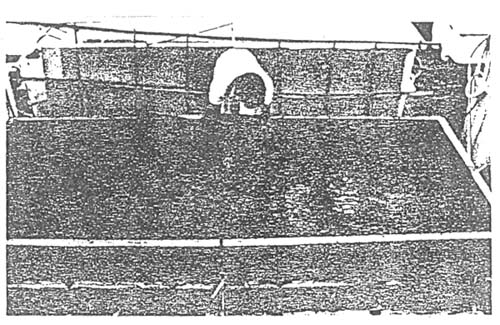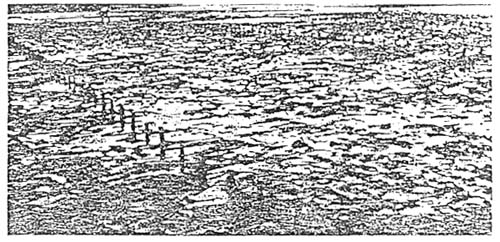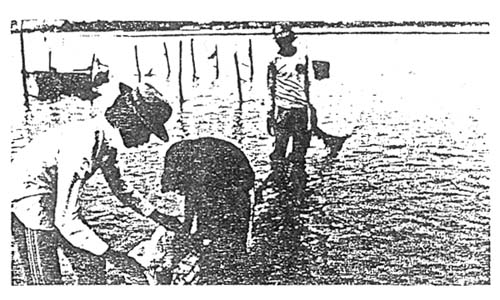Ramli Saad *
I. Abstract
This paper describes a trial of Gracilaria culture in the Middle Bank and Julutung in Penang and Ban Merbuk ponds in Kedah. Culture techniques were established but experimental results were not convincing to set up a feasible industry.
II. Introduction
Site visits and surveys around the coastal waters in Penang made by the Fisheries Research Institute (FRI) staff revealed a prolific growth of Gracilaria in the Middle Bank. This red seaweed is found to consist of two species. They are attached to a variety of substrata, the most common being the bristles which represent the stipules of Enhalus accroides the common coarse sea grass which grows in abundance on the mud bank. Samples of these Gracilaria were sent to Dr. M. S. Doty of the University of Hawaii and chemical analyses showed that a high quality gel can be extracted from one of the species identified as Gracilaria cylindrica Boergesen. Most of the branch of G. cylindrica are slender and thread-like, greenish black when live and black when dried. The second species which is still unidentified has thicker branches and turns reddish pink after treatment.
Its gel point is about 35 °C and melting point about 88 °C and thus possesses the same properties as other types of agar used for bacterial culture purposes. With these qualities, it looks like a good agar candidate and steps have been taken to implement its farming. In late 1982, a programme on Gracilaria farming was drawn up by the Fisheries Department, based on an earlier consultancy report on seaweed potential by Dr. Doty under the South China Sea Programme (Doty, 1977). Expertise from the Aquatic Resource Development Project, Hawaii, were recruited by the Bay of Bengal Small Scale Fisheries Development Programme (BOBP) and work on the experimental culture of G. cylindrica was initiated at the Fisheries Research Institute Penang in February 1983.
This paper describes the culture trials of the Gracilaria in the Middle Bank, in prawn ponds in Ban Merbok, and in cages in Jelutong.
III. Materials and Methods
Production of outplanting materials
a) From spores
A simple operational procedure was established for the production of outplanting materials. Polyethylene raffia and nylon monofilament lines were used as substrata. These lines were wound around 120 cm × 60 cm wooden frames.
The procedure involved suspending cystocarpic and/or tetrasporic Gracilaria thalli over or near the substratum by means of nylon nets set horizontally in the tanks. The netting was stretched above 20 cm over the substratum with the thalli being distributed evenly across its surface some 10 cm below the water surface level as shown in Plate 1.
Seedstock Gracilaria thalli were placed in tanks which were covered to exclude light for periods ranging from 2 to 5 days. No aeration was provided in the tanks. This was done to facilitate the spore settling and adhering to the substratum. After sporulation the cover of the tanks and the seedstock were removed and water movement was induced by means of aeration. Within a week, the seeded substrata were transferred out to the field.
b) Vegetative reproduction from thalli
Cuttings of the branches or thalli of Gracilaria were also used for vegetative regeneration growth. The thalli were either tied to the monofilament lines or placed in nettings for growth rate studies.
Planting techniques
Two basic techniques were adopted for planting the Gracilaria species. These were a monoline method for the very soft mud banks and shores on and near Penang and a loose growth method for the ponds in Ban Merbok. The first method was employed at the Pilot Farm in the Middle Bank, the second method was tried at the Ban Merbok ponds and both methods were tested at the fish cages in Jelutong.
Planting Stations
Pilot Farm at the Middle Bank
A 30m × 30m pilot farm containing three rows of 30m × 10m lines set at ½m apart, with the lines tied at each end to ½ mangrove stakes embedded into the soft mud was set up as shown in Plate 2. The lines were oriented parallel to the principal current flow. These sets of experimental lines were produced by different seeding techniques. Some were Gracilaria out-planting material produced from the Institute, some from the Jelutong fish cage, and others were non-seeded lines. Regular visits which coincided with the low tide periods were made to the farm for checking the growth and weeding of the lines.

Plate 1. Placing of seedstocks onto the net in the tank.

Plate 2. A pilot farm at the Middle Bank.
Ban Merbok Ponds
Gracilaria thalli collected from the Middle Bank were taken to the ponds in pails containing some seawater to prevent desiccation. After weighing, the thalli were either tied loosely or put in holed-bags and tied to netted frames. These frames were suspended just below the water surface or close to the pond bottom. A weekly/once a fortnight observation trip was made to the ponds.
Fish cages at Jelutong
A small experimental seeding raft was set up whereby some seeded raffia and monolines were tied around the middle of the ‘legs’ of the raft. Few groups of loose thalli were weighed and tied to the middle of the raft for growth rate studies. As a follow up two more floating units were established to produce outplanting materials outside the laboratory which would eventually supply the pilot farm operation.
IV. Observation and Results
Production of outplanting materials
The methodology for producing the outplanting material was perfected, and thousands of meters of it can be produced with the present facilities in the Fisheries Research Institute. It was handled and transported to the field by keeping it wet with seawater.
Pilot Farm at the Middle Bank
About 30 trips were made to the farm. After about 3 months, roughly 5 kg of wet Gracilaria were harvested for the first time. The best line could only give a crop of about 500 g wet weight. There were lines which did not have anything growing on them at all. Harvesting was carried out with scissors/knives for cutting the thalli and some 1–2 cm of them were left on the lines for further growth as shown in Plate 3.
The harvested materials were stored, weighed wet, limed/unlimed, dried and weighed dry. Liming apparently increases the gel strength of the agar (Doty, 1983). The dried material was either stored in the Institute or sent to Hawaii for further analysis. A second harvest was carried out 3 months later. Only 76 lines were cropped, yielding about 24.6 kg with the best line having 1,324 g, the least with 68 g and an average of 324 g.
Results from Ban Merbok ponds
During the first and second week of trial culture, the thalli responded well to the irregularities of water quality in terms of salinity, pH and ammoniacal nitrogen. The near surface pond conditions were preferred to those at the pond bottom. Towards the end of the third and fourth week water quality changed, resulting from increased rainfall, which resulted in fairly sudden decreases in salinity and pH reading. The once healthy thalli at the site deteriorated and fragmented soon after the onset of the rainy season.
Results from Jelutong raft
From the initial experimental raft culture the loose growth method gave a growth rate of 3.5% per day with both species of Gracilaria. Later attempts to produce the outplanting materials from the larger floating rafts proved to be a failure as the raffia lines became heavily sedimented and/or densely populated with epiphytes and invertebrates as shown in Plate 4.
V. Discussions
The 0.09 ha pilot farm in the Middle Bank had shown some growth since the low yield obtained in the first harvest. There were lines which did not have anything growing on them because they were unseeded. Some of those seeded were embedded under the mud and the plants were killed. It was also possible that some lines bore unviable spores.
Entanglement of green alga Ulva reticulata in farm lines posed a number of problems. Epiphytes which included Hypnea, Polysiphonia and bryozoans competed for space on the lines thus reducing the chance for the Gracilaria to grow to its maximum capacity. The rabbitfish, Siganus notably S. javus, was a major cause of Gracilaria tip damage.
Not all the lines were cropped during the second harvest. This was due to the rapid rising of the tides and more time was needed to crop the new increasing number of thalli which were growing on the lines. The average yield cropped per line was 324 g of Gracilaria. Base on this result, 180 lines in the 0.09 ha pilot farm would have produced 324 × 180 = 58,320 g. Therefore a 1 ha farm would give out 58,320 × 1/0.09 g = 648,000 g or 648 kg. At 10 centse*per wet kg this farm produce would only fetch a sum of $64.8 per ha per 3 months. At this rate of production, this whole operation is certainly not going to be economically viable. Unless the sale price is tripled or if the number of lines in the pilot farm were to be doubled or even tripled the farming of Gracilaria would be considered commercially not viable. The expenses involved in setting this farm was $143.60 for materials and $750.00 for transportation.
It appears that only vegetative production can be accomplished at Ban Merbok ponds at the moment. If and when water quality stabilises further experiments on out-growth from spores should be conducted to establish whether the Gracilaria could perpetuate themselves in the Ban Merbok pond conditions.
Taiwan is the only place in the world where Gracilaria is cultured in ponds (Shang, 1976). Tidal land and ponds previously used for milkfish production are used for the culture. The cuttings of the seaweed are used as seeding materials. About 5,000 kg of them per ha are spreaded evenly on the bottom and are held in place with upright bamboo sticks fixed to the bottom. Annual yield per ha is 7–12 tonnes of dry Gracilaria (7 kg wet seaweed yield 1 kg dry seaweed).

Plate 3. Harvesting of Gracilaria.

Plate 4. Fouling of seeded lines at Jelutong
The Jelutong fish cage site has several adverse features. These include rapid siltation of the planting lines, invertebrate epiphytization and having to cope with enormous quantities of drift waste material.
VI. Conclusions
The basic approaches have been adopted for farming both the Gracilaria species. These are the monoline method for the pilot farm and the loose growth method for the ponds. A simple operational procedure was established for the production of outplanting materials. Based on the experimental pilot farm results, seaweed farming can only fetch an income of about $259 a year and this is definitely not viable.
If Gracilaria is compared with other aquatic organisms for coastal aquaculture development in Malaysia it cannot compete in the order of priority with the commercially important food species, such as penaeid shrimps, and seabass (Lates calcarifer) for which hatchery propagation techniques have already been fairly well developed in Malaysia.
References
Doty, M.S. (1977). Seaweed Resources and their culture in the South China Sea Region, South China Sea Fisheries Development and Coordinating Programme, Working Paper.
Doty, M.S., Santos, G.A. & Ong, K.S. (1983). Agar from Gracilaria cylindrica Aquat. Bot. 15:299–306.
Santos, G.A. & Doty, M.S. (1983). Agarose from Gracilaria cylindrica. Botanica Marina, Vol. XXVI, pp. 31–34.
Santos, G.A. & Doty, M.S. (1977). Gracilaria for the Manufacture of agr. Fisheries Research Journal of the Philippines Vol. III (2):29–34.
Shang, Y.C. 91976). Economic Aspects of Gracilaria Culture in Taiwan. Aquaculture Vol. 8, pp. 1–7.